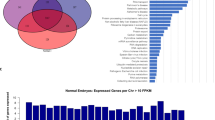Abstract
Purpose
To determine microRNA (miRNA) expression in human blastocysts relative to advanced maternal age and chromosome constitution.
Methods
Cryopreserved human blastocysts were warmed and underwent a trophectoderm biopsy for comprehensive chromosomal screening. Select blastocysts were then lysed, reverse transcribed, and pre-amplified prior to running real-time PCR. Statistical analysis was performed using an internal constant housekeeping miRNA. Significant microRNA’s of interest were then analyzed for their predicted genes and biological pathways. Additional cryopreserved blastocysts were warmed and stained for the SIRT1 protein for validation.
Results
Human blastocysts exhibit unique miRNA expression profiles in relation to maternal age and chromosome constitution. miR-93 was exclusively expressed in blastocysts from women in their forties and further up-regulated with an abnormal chromosome complement. Up-regulated miR-93 resulted in an inverse down-regulation of targets like SIRT1, resulting in reduced oxidative defense.
Conclusions
MiRNAs play an important role in aging as well as chromosome constitution and have downstream effects that regulate proteins which can compromise embryonic development.

Similar content being viewed by others
References
Bushati N, Cohen SM. microRNA functions. Annual review of cell and developmental biology. 2007;23:175–205. doi:10.1146/annurev.cellbio.23.090506.123406.
Thomas M, Lieberman J, Lal A. Desperately seeking microRNA targets. Nat Struct Mol Biol. 2010;17(10):1169–74. doi:10.1038/nsmb.1921.
Hackl M, Brunner S, Fortschegger K, Schreiner C, Micutkova L, Muck C et al. miR-17, miR-19b, miR-20a, and miR-106a are down-regulated in human aging. Aging cell. 2010;9(2):291–6. doi:10.1111/j.1474-9726.2010.00549.x.
Hooten N, Abdelmohsen K, Gorospe M, Ejiogu N, Zonderman AB, Evans MK. microRNA expression patterns reveal differential expression of target genes with age. PloS one. 2010;5 (5):e10724. doi:10.1371/journal.pone.0010724.
Kenyon C, Chang J, Gensch E, Rudner A. Tabtiang R. A C elegans mutant that lives twice as long as wild type Nature. 1993;366(6454):461–4. doi:10.1038/366461a0.
Smith-Vikos T, Slack FJ. MicroRNAs and their roles in aging. J Cell Sci. 2012;125(Pt 1):7–17. doi:10.1242/jcs.099200.
Campisi J. d'Adda di Fagagna F. Cellular senescence: when bad things happen to good cells. Nat Rev Mol Cell Biol. 2007;8(9):729–40.
Selesniemi K, Lee HJ, Muhlhauser A, Tilly JL. Prevention of maternal aging-associated oocyte aneuploidy and meiotic spindle defects in mice by dietary and genetic strategies. Proc Natl Acad Sci U S A. 2011;108(30):12319–24. doi:10.1073/pnas.1018793108.
Lodish H, Berk A, Zipursky SL, et al. Molecular cell biology. New York: W. H. Freeman; 2000.
Reproductive E, Infertility C. Family physicians advisory C, maternal-fetal medicine C, executive, council of the society of O et al. Advanced reproductive age and fertility. Journal of obstetrics and gynaecology Canada : JOGC. Journal d'obstetrique et gynecologie du Canada : JOGC. 2011;33(11):1165–75.
Calin GA, Croce CM. MicroRNAs and chromosomal abnormalities in cancer cells. Oncogene. 2006;25(46):6202–10. doi:10.1038/sj.onc.1209910.
Li N, Muthusamy S, Liang R, Sarojini H, Wang E. Increased expression of miR-34a and miR-93 in rat liver during aging, and their impact on the expression of Mgst1 and Sirt1. Mech Ageing Dev. 2011;132(3):75–85. doi:10.1016/j.mad.2010.12.004.
Campagna M, Herranz D, Garcia MA, Marcos-Villar L, Gonzalez-Santamaria J, Gallego P, et al. SIRT1 stabilizes PML promoting its sumoylation. Cell Death Differ. 2011;18(1):72–9. doi:10.1038/cdd.2010.77.
Xia H, Qi Y, Ng SS, Chen X, Chen S, Fang M, et al. MicroRNA-15b regulates cell cycle progression by targeting cyclins in glioma cells. Biochem Biophys Res Commun. 2009;380(2):205–10. doi:10.1016/j.bbrc.2008.12.169.
Kregel KC, Zhang HJ. An integrated view of oxidative stress in aging: basic mechanisms, functional effects, and pathological considerations. American journal of physiology Regulatory, integrative and comparative physiology. 2007;292(1):R18–36. doi:10.1152/ajpregu.00327.2006.
Agarwal A, Aponte-Mellado A, Premkumar BJ, Shaman A, Gupta S. The effects of oxidative stress on female reproduction: a review. Reproductive biology and endocrinology : RB & E. 2012;10:49. doi:10.1186/1477-7827-10-49.
Hasegawa K, Wakino S, Yoshioka K, Tatematsu S, Hara Y, Minakuchi H, et al. Sirt1 protects against oxidative stress-induced renal tubular cell apoptosis by the bidirectional regulation of catalase expression. Biochem Biophys Res Commun. 2008;372(1):51–6. doi:10.1016/j.bbrc.2008.04.176.
Maes OC, An J, Sarojini H, Wang E. Murine microRNAs implicated in liver functions and aging process. Mech Ageing Dev. 2008;129(9):534–41. doi:10.1016/j.mad.2008.05.004.
Gardner DK, Schoolcraft WB. In-vitro culture of human blastocysts. In: Jansen R, Mortimer D, editors. Towards reproductive certainty: fertility and genetics beyond 1999. Carnforth: Parthenon Press; 1999. p. 378–88.
Schoolcraft WB, Treff NR, Stevens JM, Ferry K, Katz-Jaffe M, Scott Jr RT. Live birth outcome with trophectoderm biopsy, blastocyst vitrification, and single-nucleotide polymorphism microarray-based comprehensive chromosome screening in infertile patients. Fertil Steril. 2011;96(3):638–40. doi:10.1016/j.fertnstert.2011.06.049.
Treff NR, Scott Jr RT. Four-hour quantitative real-time polymerase chain reaction-based comprehensive chromosome screening and accumulating evidence of accuracy, safety, predictive value, and clinical efficacy. Fertil Steril. 2012. doi:10.1016/j.fertnstert.2012.11.007.
Kuwayama M. Highly efficient vitrification for cryopreservation of human oocytes and embryos: the Cryotop method. Theriogenology. 2007;67(1):73–80. doi:10.1016/j.theriogenology.2006.09.014.
Albertini MR, Nicklas JA, Chastenay BF, Hunter TC, Albertini RJ, Clark SS, et al. Analysis of T cell receptor beta and gamma genes from peripheral blood, regional lymph node and tumor-infiltrating lymphocyte clones from melanoma patients. Cancer immunology, immunotherapy : CII. 1991;32(5):325–30.
Author information
Authors and Affiliations
Corresponding author
Additional information
Capsule MiRNAs play an important role in aging as well as chromosome constitution and have downstream effects that regulate proteins which can compromise embryonic development.
Rights and permissions
About this article
Cite this article
McCallie, B.R., Parks, J.C., Strieby, A.L. et al. Human blastocysts exhibit unique microrna profiles in relation to maternal age and chromosome constitution. J Assist Reprod Genet 31, 913–919 (2014). https://doi.org/10.1007/s10815-014-0235-y
Received:
Accepted:
Published:
Issue Date:
DOI: https://doi.org/10.1007/s10815-014-0235-y




